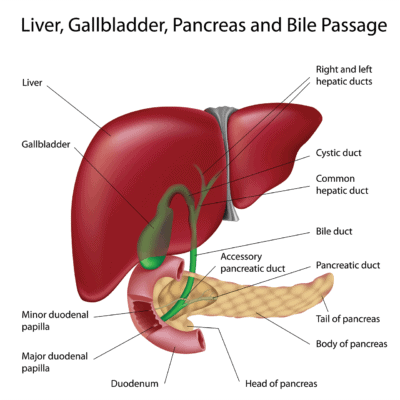Can the Body Repair Its Own Pancreas?
Can the body repair its own pancreas? While the imagery that comes to mind might seem like something out of a science-fiction novel, the truth is that real science is outsmarting the fiction here. All indicators, according to a recent study, are that if we set up the right environment, the body can likely repair its own damaged pancreatic cells.
Damaged pancreatic cells can lead to diabetes, and this is a key focus in the research—if the body can repair its own pancreas, do we have a potential treatment for diabetes? Before I discuss the study, let’s review the pancreas and diabetes.
The Pancreas and Diabetes

Alila Medical Media/Shutterstock
The pancreas is roughly a tadpole-shaped organ (with a head, body, and tail) that lives behind our stomach. Its head nestles into the inner curve of our duodenum (the first part of the small intestine that our stomach contents empty into) where it connects via the pancreatic duct. Its body and tail span the width of our stomach, ending on the left side of our abdomen at the spleen.
The pancreas functions of part of both the gastrointestinal, or digestive, system and the endocrine system. Though it has other functions, most people know it best, by far, as the gland that releases the hormone insulin to help keep our blood sugar levels under control. And the reason they know it is because when the pancreas isn’t releasing insulin properly, this can lead to diabetes, an extremely prevalent disease in the United States. On its website, the American Diabetes Association provides the following 2012 statistics on Diabetes in the U.S.:
- 29.1 million (9.3%) Americans have diabetes
- 1.4 million are newly diagnosed each year
- 86 million age 20 and older have prediabetes
- Diabetes is the 7th leading cause of death in the U.S.
The specific cells within the pancreas that produce, store, and secrete insulin are the beta cells. Therefore, damaged or destroyed beta cells can lead to type 1 diabetes, type 2 diabetes, or prediabetes (where the blood sugar is high but not yet high enough to be diagnosed with type 2 diabetes). When we ask if the body can repair its own pancreas, it’s those beta cells we want to repair so we can keep the insulin flowing.
The Right Environment for Pancreatic Cell Repair
I mentioned earlier in the post that if we set up the right environment, the body can likely repair its own cells. So what is the right environment? For the purposes of this recent study, the right environment was a fasting-mimicking diet (FMD). The FMD runs in cycles of 30 days. The first 5 days of the cycle, subjects consume low amounts of calories, proteins, and carbohydrates and high amounts of unsaturated fats. During the following 25 days of the cycle, there are no dietary restrictions and participants can eat anything they want, and then the 30-day cycle begins again. Researchers in the study were looking at the affects of an FMD on the pancreas.
The Study: The Fasting-Mimicking Diet Reprograms the Pancreas
The study results in mice show that a modified fasting-mimicking diet (FMD) restores insulin secretion, or, more specifically, reprograms “pancreatic cells to restore insulin generation” in type 1 and type 2 diabetes. In other words, the diet seems to jump-start the pancreas, which in turn restores insulin secretion in diabetics. The specific pancreatic cells the diet impacts are the beta cells, which, as mentioned before, are responsible for releasing insulin when blood sugar increases. One of the study’s authors concluded, “We’ve shown—at least in mouse models—that you can use diet to reverse the symptoms of diabetes.”
The upshot? So can the FMD allow the body to repair its own damaged pancreatic beta cells and reverse the symptoms of diabetes? In mice, yes, but we need to see FMD results in humans. However, this study has much bigger implications. First, it highlights the importance of having the right local microenvironment to heal cells. This is why we’re spending so much time on our local microenvironment study for knee arthritis. Second, changing your diet to mimic the FMD is a heck of a lot less risky than taking diabetes pills, so why not give it a whirl?

If you have questions or comments about this blog post, please email us at [email protected]
NOTE: This blog post provides general information to help the reader better understand regenerative medicine, musculoskeletal health, and related subjects. All content provided in this blog, website, or any linked materials, including text, graphics, images, patient profiles, outcomes, and information, are not intended and should not be considered or used as a substitute for medical advice, diagnosis, or treatment. Please always consult with a professional and certified healthcare provider to discuss if a treatment is right for you.
